外研社必修3 module 6 old and new单元练习附答案解析
文档属性
| 名称 | 外研社必修3 module 6 old and new单元练习附答案解析 | 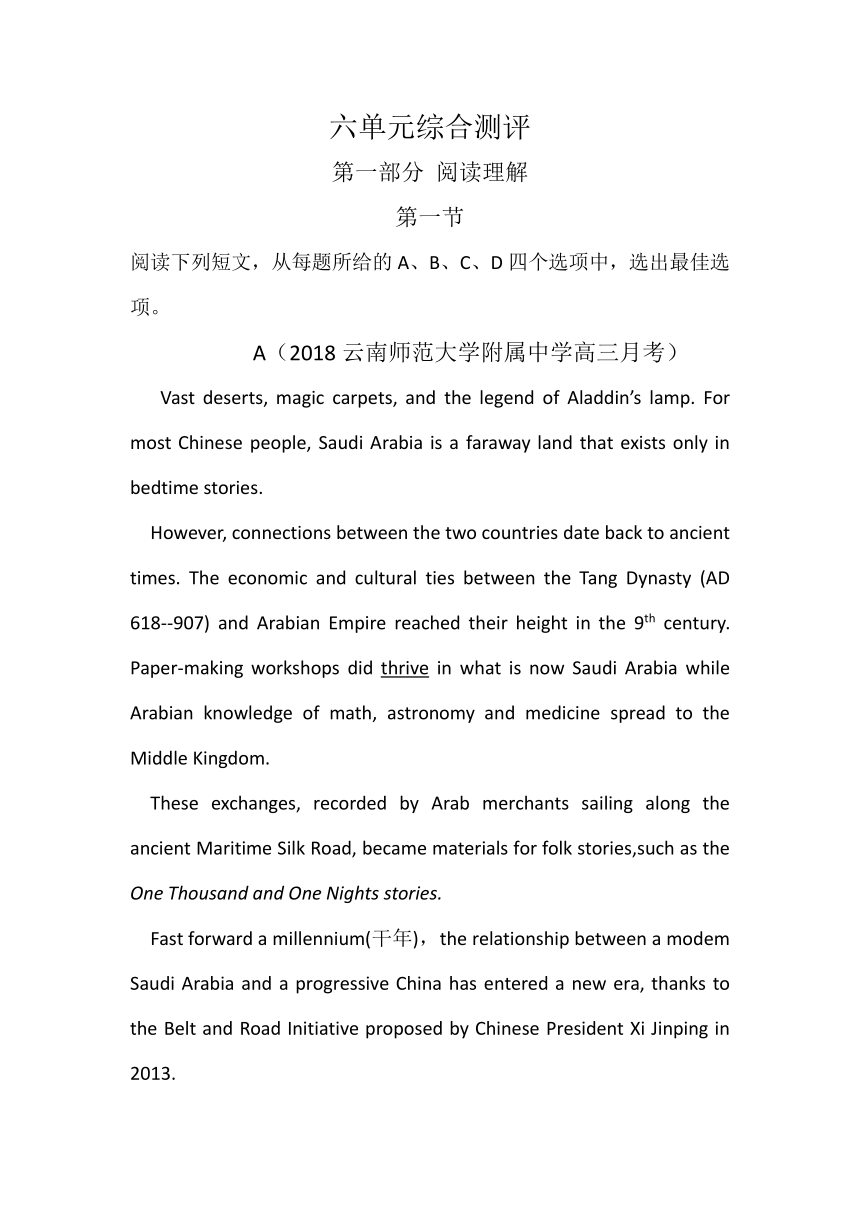 | |
| 格式 | zip | ||
| 文件大小 | 28.4KB | ||
| 资源类型 | 教案 | ||
| 版本资源 | 外研版 | ||
| 科目 | 英语 | ||
| 更新时间 | 2020-05-18 19:30:56 | ||
图片预览

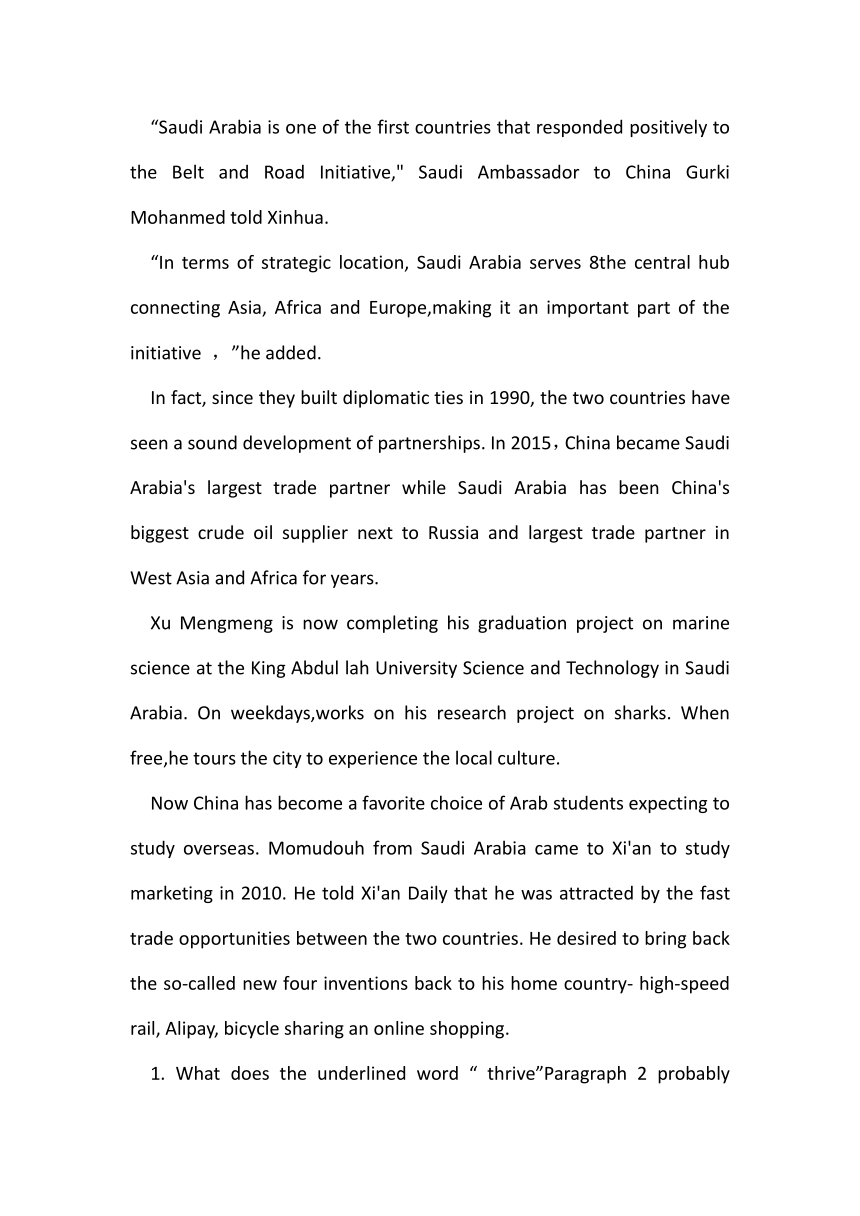
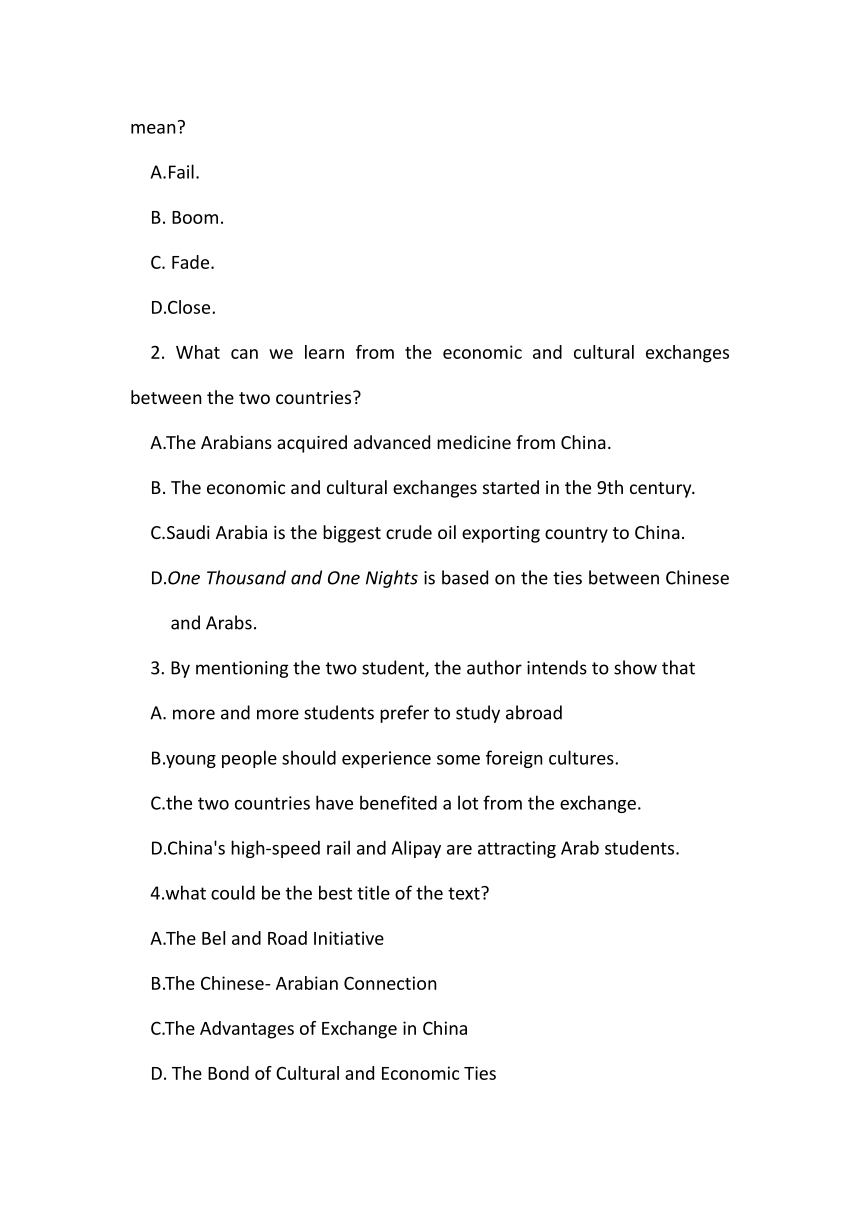
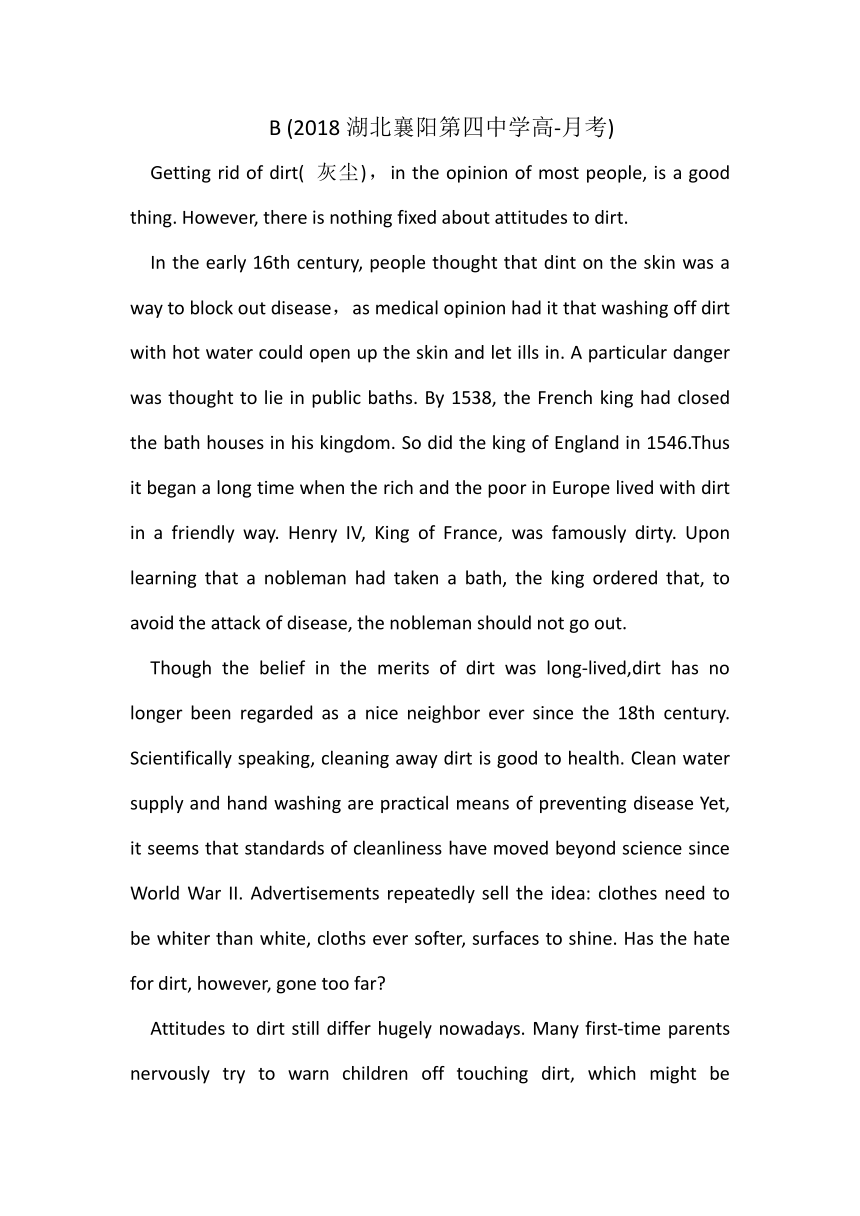
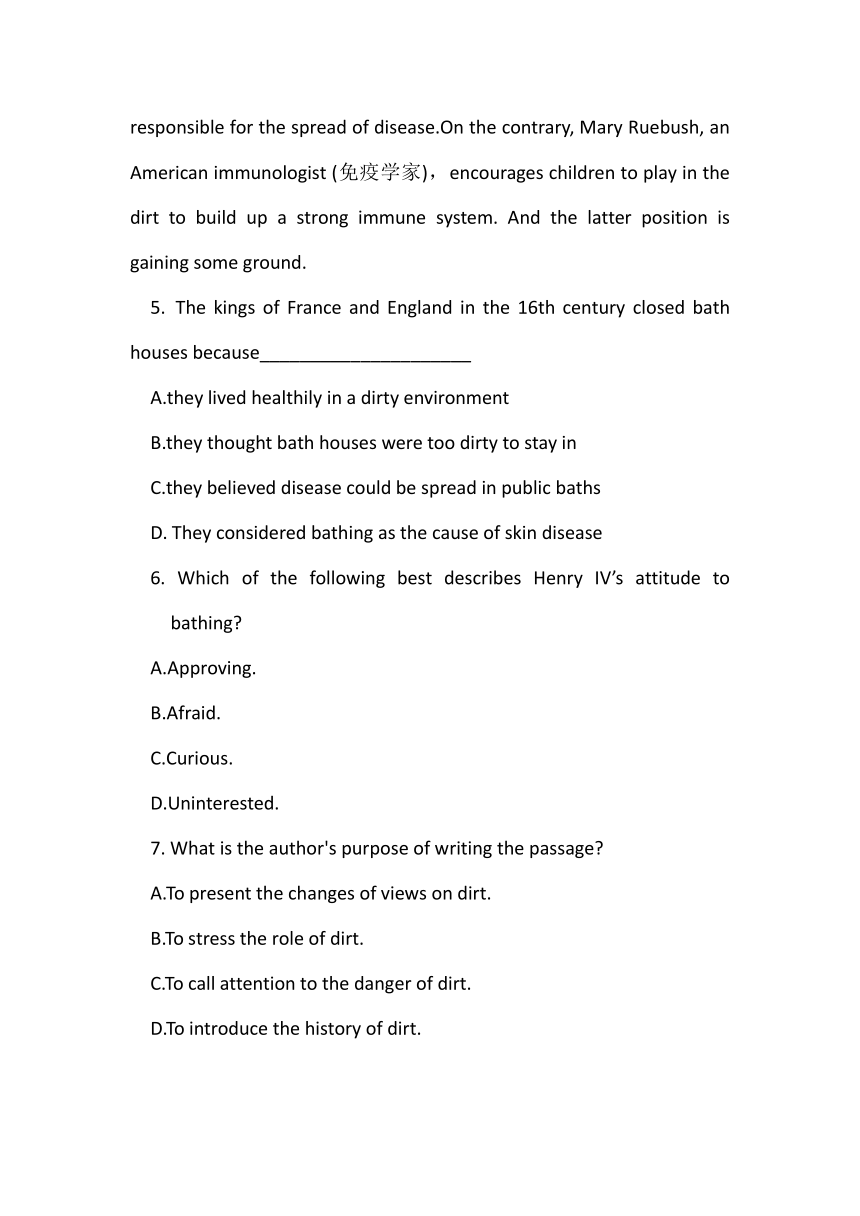
文档简介
六单元综合测评
阅读理解
第一节
阅读下列短文,从每题所给的A、B、C、D四个选项中,选出最佳选项。
A(2018云南师范大学附属中学高三月考)
Vast deserts, magic carpets, and the legend of Aladdin’s lamp. For most Chinese people, Saudi Arabia is a faraway land that exists only in bedtime stories.
However, connections between the two countries date back to ancient times. The economic and cultural ties between the Tang Dynasty (AD 618--907) and Arabian Empire reached their height in the 9th century. Paper-making workshops did thrive in what is now Saudi Arabia while Arabian knowledge of math, astronomy and medicine spread to the Middle Kingdom.
These exchanges, recorded by Arab merchants sailing along the ancient Maritime Silk Road, became materials for folk stories,such as the One Thousand and One Nights stories.
Fast forward a millennium(干年),the relationship between a modem Saudi Arabia and a progressive China has entered a new era, thanks to the Belt and Road Initiative proposed by Chinese President Xi Jinping in 2013.
“Saudi Arabia is one of the first countries that responded positively to the Belt and Road Initiative," Saudi Ambassador to China Gurki Mohanmed told Xinhua.
“In terms of strategic location, Saudi Arabia serves 8the central hub connecting Asia, Africa and Europe,making it an important part of the initiative ,”he added.
In fact, since they built diplomatic ties in 1990, the two countries have seen a sound development of partnerships. In 2015,China became Saudi Arabia's largest trade partner while Saudi Arabia has been China's biggest crude oil supplier next to Russia and largest trade partner in West Asia and Africa for years.
Xu Mengmeng is now completing his graduation project on marine science at the King Abdul lah University Science and Technology in Saudi Arabia. On weekdays,works on his research project on sharks. When free,he tours the city to experience the local culture.
Now China has become a favorite choice of Arab students expecting to study overseas. Momudouh from Saudi Arabia came to Xi'an to study marketing in 2010. He told Xi'an Daily that he was attracted by the fast trade opportunities between the two countries. He desired to bring back the so-called new four inventions back to his home country- high-speed rail, Alipay, bicycle sharing an online shopping.
1. What does the underlined word “ thrive”Paragraph 2 probably mean?
A.Fail.
B. Boom.
C. Fade.
D.Close.
2. What can we learn from the economic and cultural exchanges between the two countries?
A.The Arabians acquired advanced medicine from China.
B. The economic and cultural exchanges started in the 9th century.
C.Saudi Arabia is the biggest crude oil exporting country to China.
D.One Thousand and One Nights is based on the ties between Chinese and Arabs.
3. By mentioning the two student, the author intends to show that
A. more and more students prefer to study abroad
B.young people should experience some foreign cultures.
C.the two countries have benefited a lot from the exchange.
D.China's high-speed rail and Alipay are attracting Arab students.
4.what could be the best title of the text?
A.The Bel and Road Initiative
B.The Chinese- Arabian Connection
C.The Advantages of Exchange in China
D. The Bond of Cultural and Economic Ties
B (2018湖北襄阳第四中学高-月考)
Getting rid of dirt( 灰尘),in the opinion of most people, is a good thing. However, there is nothing fixed about attitudes to dirt.
In the early 16th century, people thought that dint on the skin was a way to block out disease,as medical opinion had it that washing off dirt with hot water could open up the skin and let ills in. A particular danger was thought to lie in public baths. By 1538, the French king had closed the bath houses in his kingdom. So did the king of England in 1546.Thus it began a long time when the rich and the poor in Europe lived with dirt in a friendly way. Henry IV, King of France, was famously dirty. Upon learning that a nobleman had taken a bath, the king ordered that, to avoid the attack of disease, the nobleman should not go out.
Though the belief in the merits of dirt was long-lived,dirt has no longer been regarded as a nice neighbor ever since the 18th century. Scientifically speaking, cleaning away dirt is good to health. Clean water supply and hand washing are practical means of preventing disease Yet, it seems that standards of cleanliness have moved beyond science since World War II. Advertisements repeatedly sell the idea: clothes need to be whiter than white, cloths ever softer, surfaces to shine. Has the hate for dirt, however, gone too far?
Attitudes to dirt still differ hugely nowadays. Many first-time parents nervously try to warn children off touching dirt, which might be responsible for the spread of disease.On the contrary, Mary Ruebush, an American immunologist (免疫学家),encourages children to play in the dirt to build up a strong immune system. And the latter position is gaining some ground.
The kings of France and England in the 16th century closed bath houses because_____________________
A.they lived healthily in a dirty environment
B.they thought bath houses were too dirty to stay in
C.they believed disease could be spread in public baths
D. They considered bathing as the cause of skin disease
6. Which of the following best describes Henry IV’s attitude to bathing?
A.Approving.
B.Afraid.
C.Curious.
D.Uninterested.
7. What is the author's purpose of writing the passage?
A.To present the changes of views on dirt.
B.To stress the role of dirt.
C.To call attention to the danger of dirt.
D.To introduce the history of dirt.
C (2018辽宁鞍山第一中学高二下学期期中)
Researchers are tying to figure out exactly when a where a lizard got tapped in the sap(汁、液) of a tree. Over time, the tree sap turned into amber (琥珀)preserving the lizard's mains, which a man discovered an donated to the Miller Museum of Geology at Queen University. But the man didn't report the amber’s age and where he got it.
“The man who donated it died, unfortunately," Said Ellen Handyside, an undergraduate student at Queen University. “We are really starting from scratch determining its history." Ellen Handyide is leading the research into the amber-surrounded lizard. She and her colleagues analyzed the chemical composition of the 4.7- inch-long piece of amber and learned some facts. “The amber was not actually artificial,”she told Live Science, “and we found that it did match up quite well to an amber sample.”
The researchers analyzed the amber's carbon a isotopes(同位素) and the results indicated that the amber was formed from the sap of a flowering tree. Moreover,the results suggested that the tree and the lizard ,for that matter, lived in an area with a lot of rainfall an dated from the Neogene, a period that lasted from the end the Paleogene Period 23. 03 million years ago to the beginning of the present Quatemary Period. Next, the scientific team realized that the 2. 7-inch-long lizard was likely a gecko(壁虎),according to a detailed, 3D, digital model of the animal's body that the researchers created through X-ray microscopy scans.
“We looked at the skull- the teeth were in place and the ear bones were there too, And we've even got some flesh, skin and its long toes," Handyside said. “It's fantastic!" She said she hoped that they could figure out how the creature ft into the gecko family tee. “When you think of a gecko, you think of short and fat toes and sticky pads. That isn't what we're looking at, but it's more likely to live in trees. If it were a tree-living creature, then its death actually could make more sense," Handyside said.
What can probably be inferred about the amber?
It was obtained by a museum at a low price.
Its original owner knew nothing about it.
It was found to be a unique type of amber.
lts donor didn't say much about its history.
What can we learn from Handyside's words?
A. The lizard's death was caused by a gecko.
B. The lizard has fat and short toes. C.The lizard is preserved very well.
D.The lizard belongs to the tree-living creature.
10. What does the author mainly tell us in this passage?
A.The discovery of a piece of natural amber.
B.The mystery about a piece of amber.
C.The research into a piece of amber.
D.The meaningful death of a lizard.
第二节
根据短文内容,从短文后的选项中选出能填入空白处的最佳选项。选项中有两项为多余选项。(2018河南豫南九校下学期联考)
China has been the birthplace of many of the world's greatest inventions. It was, for example, the first country to produce paper money. Before the invention of paper money and coins, people used many different kinds of things for buying and selling. 11 This exchange of goods and services for other goods and services is called bartering.
12 In 1200 BC, people in China began to use shells(贝壳) as money. Usually the shells used as money were very small. This made it easier for people to carry money over long distances, and allowed for trade to develop between different parts of the country.
In the years which followed this invention, many other countries around the world began to do the same. 13
The next development was in 1000 BC, when China started making bronze and copper shells. It wasn't long before the Chinese made round coins out of metal. 14 By 500 BC, metal coins had begun to appear in countries like Persia and Greece, and later in the Roman Empire.
About 1000 years later, leather was used as money in China, and in 8066AD, the first paper banknotes were produced by the Chinese people. 15
People also began collecting foreign coins as souvenirs
However, as economies developed, such exchanges became impractical.
It was still many years before paper currency appeared in Europe.
They also used tiny shells as money for buying and selling.
As time went by, trade between countries increased.
During that time, for example, buying a chicken might cost several potatoes.
The very first coins often had holes in them so that people could string them together.
第二部分 语言运用
第一节完形填空
(2018四川棠湖中高三月考)
I live in a rural community in the United States. A rural area is different from a city because there are 16 people. My home is deep in a valley 17 by mountains that are rocky and covered in trees. 18 many farms are located in rural areas because they require plots of land to grow food or 19 farm animals, in my community the mountains and 20 soil make it difficult to farm. This is one 21 why few people live in my area.
What’s it like to live in the mountains? Since we have a lot of 22 ,we get to have horses and chickens. My family 23 eggs from the chickens for breakfast. We also lose electricity a lot because the trees fall on power lines whenever there’s a 24 . In my community, people keep battery-powered flashlights and oil lamps stored in case the lights 25 .
Some people also use a generator--a machine that generates electricity from gasoline-- whenever there are 26 .
Going to school in a rural area means having fewer classmates and 27 longer distances. To get to my high school, I must dive forty miles to the 28 city. This means I must get p much earlier than my 29 classmates in order to be on time. The roads in my community aren't paved with asphalt(沥青) either, so during storms they 30 become too muddy or snowy to pass. In cities a snowplow(扫雪机)_ 31 quickly, but areas where fewer people live aren't the priority, so days can pass before a snowplow 32 the road. Sometimes I must miss school because storms make it 33 to drive.
I am not sure 34 if I want to live in the country or in the city when I grow up. I like being in nature, hearing the creek and the birds, and having a big yard. I also like being in the city,though, where I can go howling or skating, or see my friends. It can get 35 in the country, although I do love being around our animals.
A. few B. many C. fewer D. more
A. surrounded B. hidden C. shadowed D. enriched
A. When B. While C. Because D. If
A. feed B. grow C. train D. house
A. rich B. muddy C. rocky D. snowy
A. explanation B. cause C. excuse D. reason
A. space B. room C. place D. land
A. lays B. harvest C. buys D. picks
A. storm B. thunder C. lightening D. shower
A. put out B. wear out C. run out D. go out
A. danger B. risks C. emergencies D. incidents
A. walking B. running C. driving D. traveling
A. nearby B. distant C. nearest D. farther
A. rural B. city C. old D. new
A. can B. may C. must D. should
A. comes by B. comes about C. comes to D. comes out
A. cleans B. digs C. clears D. covers
A. likely B. necessary C. improper D. impossible
A. still B. yet C. even D. as
A. quiet B. lonely C. alone D. busy
参考答案:
B词义猜测题。 根据文章第二段可知唐朝时中国和沙特阿拉伯的经济文化交流达到了鼎盛时期,造纸工厂在沙特阿拉伯繁荣发展。故选B。
D 细节理解题。根据第三段中的These exchanges . recorded by Anb merchants sailing along the ancient Maritime Silk Road ,became materials for folk stories, such as the One Thousand and One Nights stories.得知,《一千零一夜)的故事主 要源于中国和阿拉伯国家商人的海上贸易往来。故选D。
3.C 推理判断题。结合第七段的内容可知,举两国交换生的例子是为了进一步说明两国受益于相互间的经济文化交流。故选C。
4.B 主旨大意题。本文围绕中沙两国的古今联系展开,从古代“丝绸之路”讲到了“一带一路”,故选B。
B语篇解读本文主要讲述的是在历史的发展过程中,人们对于灰尘的看法在不停地发生着变化。
5.C细节理解题。根据第二段中的“as ,medical opinion had it that washing off dirt with hot water could open up the skin and let ills in. A particular danger was thought to lie in pubic baths."可知,他们认为在浴室里洗澡会传染疾病,所以才下令关闭浴室。故选C。
6. B 推理判断题。根据第二段最后两句Henry I, King of France, was famously dirty. Upon learning that a nobleman had taken a bath, the king ordered that, to avoid the attack of disease, the nobleman should not go out."可知,他很害怕洗澡后会使疾病传播,故选B.
7.A文章主题段第一段Getting rid of dirt, in the opinion of most people, is a good thing-However, there is nothing fixed about attitudes to dirt.和最后段第一 句Attitudes to dirt still differ hugely 变化都说明人们对于灰尘的看法是在不停的变化之中的,故选A。
C(语篇解读)本文是一篇说明文。文章讲述的是研究者对一块现珀的研究经过。
8.D 细节理解题。根据第一段最后一句But the man didn't report the amber's age and where he got it.可知,琥珀的捐赠者并没有过多地谈论它的来历。故D项正确。
9.C 推理判断题。根据最后一段中“We looked at the skull- the teeth were in place and the ear bones were there too. And we've even got some flesh, skin and its long toes," Handyside said. “It's fantastic!"可知,这只蜥蜴保存得很好。故C项正确。
10.C 主旨大意题。根据第一段中的Researchers are trying to figure out exactly when and where a lizard got tapped in the sap(汁液) of a tee. Over time, the tree sap turned into amber (琥珀),preserving the lizard's mains可知,本文叙述的是研究者对块琥珀的研究经过。 故C项正确。
第二节
语篇解读文中介绍了货币的发展过程,由实物交换到贝壳货币再到金属硬币,最后中国首先发明了纸币。
11.F 空前句意:在纸币和硬币发明之前,人们用许多不同的东西来买卖。分析句意可知,最初人们用实物来买卖。F项是用实物买卖的例子,是对前一句的进一步解释。
12.B 根据下文的内容可知,在公元前1200年,使用贝壳作为货币,可以方便出远门时随身携带。而以物易物的方式变得很不实用。故选B项.
13.D 根据上句内容, 在这项发明之后的岁月里,世界上许多其他国家也开始这样做,即它们也使用贝壳来作为货币。故选D。
14.G 根据本空的上下文内容可知,这时货币出现了新的发展,即出现金属币。G项中的coins与前后句中的coins属于原词的复现。故选G。
15.C 本段主要讲述了纸币最早出现在中国。分析选项可知,C 项中的paper currency 与前面的paper banknotes对应故选C项。
第二部分语言运用
第一节语篇解读作者通过自己的亲身经历,将农村生活和城市生活进行了对比,分析了在农村居住的好处和不足。
16.C 此处指农村和城市不同,农村的人少。
17.A 根据deep in a valley和by mountains 可知,作者的家在被群山环绕的山谷深处故选A。
18.B 此处与第20空前后的内容是让步关系,故用while.
19.D 此处指农场需要大块的土地小畜提供住处故选D。
20.C 此处指在作者的家乡,多石的土壤使农作物难以生长,故选C。
21.D家乡的土壤不适合耕种, 这是家乡人少的房因。reason 通常指产生某种行为或想法的理由而cause通常指导致某一事件发生的起因。 故进D。explanation解释;cause原因起因: excuse信口;reason原因。
22.A此处指住在农村的好处, 有大空间,可以养马和鸡。故选A。
23.B我们家养着鸡, 所以可以收获鸡蛋作为早餐,故选B.
24.A我们也经常停电 ,因为每当有暴风雨的时候,树就会倒到电线上,造成停电,故选A。
25.D put out扑灭,熄灭(指某人将某物熄灭,强调动作) ;wear out磨损,穿破;run out耗尽;go out熄灭(经常指灯自己熄灭)。此处指由于停电灯熄灭了,故选D。
26.C此处指发生紧急情况时,人们也使用一种通过烧汽油发电的发电机。故选C。
27.D在农村上学意味 着有较少的同学和走较远的距离。因为人烟稀少,学校少,所以上学很远。此处并没有说上学的具体交通方式,只是总说。故选D。
28.C nearby 附近的:Distant遥远的;nearest最近的:Farthest 最远的。上高中时作者要开车四十英里到达最近的城市,这是为了说明上学路途远,故选C。
29.B 早起床。为了按时上学,作者必须比城市里的同学更表示对比故选B.
30A农村的道路不是沥青路,所以雨雪天会变得非常泥泞。根据句意可知选A。
31.A come by经过;come about发生;come to谈到;come out出现。在城市里,下雪后扫雪机会很快经过,把雪扫干净。故选A。
32.C clean 打扫;dig挖;clear清除;cover覆盖。此处指扫雪机清除积雪,使路面干净。故选C。
33.D likely很可能的necessary必要的;improper错误的;impossible不可能的。因为农村道路雨雪后泥泞,雨雪使道路不能开车,作者不能去上学。故选D。
34.B still 常用于肯定句中,表示“某事仍在进行中”,一般与现在时态或进行时态连用。也可用在疑问句或否定句中,在否定句中须放在否定词not 之前。yet 表示"某事尚未发生”,多用于否定句或带否定词的陈述句中。此处用于否定句,表示我现在仍然不确定,故选B。
35.B quiet安静的:lonely寂寞的: alone独自的:busy忙碌的。因为农村人少,所以尽管我喜欢和动物在一起,但农村仍会让人感到寂寞。故选B。
阅读理解
第一节
阅读下列短文,从每题所给的A、B、C、D四个选项中,选出最佳选项。
A(2018云南师范大学附属中学高三月考)
Vast deserts, magic carpets, and the legend of Aladdin’s lamp. For most Chinese people, Saudi Arabia is a faraway land that exists only in bedtime stories.
However, connections between the two countries date back to ancient times. The economic and cultural ties between the Tang Dynasty (AD 618--907) and Arabian Empire reached their height in the 9th century. Paper-making workshops did thrive in what is now Saudi Arabia while Arabian knowledge of math, astronomy and medicine spread to the Middle Kingdom.
These exchanges, recorded by Arab merchants sailing along the ancient Maritime Silk Road, became materials for folk stories,such as the One Thousand and One Nights stories.
Fast forward a millennium(干年),the relationship between a modem Saudi Arabia and a progressive China has entered a new era, thanks to the Belt and Road Initiative proposed by Chinese President Xi Jinping in 2013.
“Saudi Arabia is one of the first countries that responded positively to the Belt and Road Initiative," Saudi Ambassador to China Gurki Mohanmed told Xinhua.
“In terms of strategic location, Saudi Arabia serves 8the central hub connecting Asia, Africa and Europe,making it an important part of the initiative ,”he added.
In fact, since they built diplomatic ties in 1990, the two countries have seen a sound development of partnerships. In 2015,China became Saudi Arabia's largest trade partner while Saudi Arabia has been China's biggest crude oil supplier next to Russia and largest trade partner in West Asia and Africa for years.
Xu Mengmeng is now completing his graduation project on marine science at the King Abdul lah University Science and Technology in Saudi Arabia. On weekdays,works on his research project on sharks. When free,he tours the city to experience the local culture.
Now China has become a favorite choice of Arab students expecting to study overseas. Momudouh from Saudi Arabia came to Xi'an to study marketing in 2010. He told Xi'an Daily that he was attracted by the fast trade opportunities between the two countries. He desired to bring back the so-called new four inventions back to his home country- high-speed rail, Alipay, bicycle sharing an online shopping.
1. What does the underlined word “ thrive”Paragraph 2 probably mean?
A.Fail.
B. Boom.
C. Fade.
D.Close.
2. What can we learn from the economic and cultural exchanges between the two countries?
A.The Arabians acquired advanced medicine from China.
B. The economic and cultural exchanges started in the 9th century.
C.Saudi Arabia is the biggest crude oil exporting country to China.
D.One Thousand and One Nights is based on the ties between Chinese and Arabs.
3. By mentioning the two student, the author intends to show that
A. more and more students prefer to study abroad
B.young people should experience some foreign cultures.
C.the two countries have benefited a lot from the exchange.
D.China's high-speed rail and Alipay are attracting Arab students.
4.what could be the best title of the text?
A.The Bel and Road Initiative
B.The Chinese- Arabian Connection
C.The Advantages of Exchange in China
D. The Bond of Cultural and Economic Ties
B (2018湖北襄阳第四中学高-月考)
Getting rid of dirt( 灰尘),in the opinion of most people, is a good thing. However, there is nothing fixed about attitudes to dirt.
In the early 16th century, people thought that dint on the skin was a way to block out disease,as medical opinion had it that washing off dirt with hot water could open up the skin and let ills in. A particular danger was thought to lie in public baths. By 1538, the French king had closed the bath houses in his kingdom. So did the king of England in 1546.Thus it began a long time when the rich and the poor in Europe lived with dirt in a friendly way. Henry IV, King of France, was famously dirty. Upon learning that a nobleman had taken a bath, the king ordered that, to avoid the attack of disease, the nobleman should not go out.
Though the belief in the merits of dirt was long-lived,dirt has no longer been regarded as a nice neighbor ever since the 18th century. Scientifically speaking, cleaning away dirt is good to health. Clean water supply and hand washing are practical means of preventing disease Yet, it seems that standards of cleanliness have moved beyond science since World War II. Advertisements repeatedly sell the idea: clothes need to be whiter than white, cloths ever softer, surfaces to shine. Has the hate for dirt, however, gone too far?
Attitudes to dirt still differ hugely nowadays. Many first-time parents nervously try to warn children off touching dirt, which might be responsible for the spread of disease.On the contrary, Mary Ruebush, an American immunologist (免疫学家),encourages children to play in the dirt to build up a strong immune system. And the latter position is gaining some ground.
The kings of France and England in the 16th century closed bath houses because_____________________
A.they lived healthily in a dirty environment
B.they thought bath houses were too dirty to stay in
C.they believed disease could be spread in public baths
D. They considered bathing as the cause of skin disease
6. Which of the following best describes Henry IV’s attitude to bathing?
A.Approving.
B.Afraid.
C.Curious.
D.Uninterested.
7. What is the author's purpose of writing the passage?
A.To present the changes of views on dirt.
B.To stress the role of dirt.
C.To call attention to the danger of dirt.
D.To introduce the history of dirt.
C (2018辽宁鞍山第一中学高二下学期期中)
Researchers are tying to figure out exactly when a where a lizard got tapped in the sap(汁、液) of a tree. Over time, the tree sap turned into amber (琥珀)preserving the lizard's mains, which a man discovered an donated to the Miller Museum of Geology at Queen University. But the man didn't report the amber’s age and where he got it.
“The man who donated it died, unfortunately," Said Ellen Handyside, an undergraduate student at Queen University. “We are really starting from scratch determining its history." Ellen Handyide is leading the research into the amber-surrounded lizard. She and her colleagues analyzed the chemical composition of the 4.7- inch-long piece of amber and learned some facts. “The amber was not actually artificial,”she told Live Science, “and we found that it did match up quite well to an amber sample.”
The researchers analyzed the amber's carbon a isotopes(同位素) and the results indicated that the amber was formed from the sap of a flowering tree. Moreover,the results suggested that the tree and the lizard ,for that matter, lived in an area with a lot of rainfall an dated from the Neogene, a period that lasted from the end the Paleogene Period 23. 03 million years ago to the beginning of the present Quatemary Period. Next, the scientific team realized that the 2. 7-inch-long lizard was likely a gecko(壁虎),according to a detailed, 3D, digital model of the animal's body that the researchers created through X-ray microscopy scans.
“We looked at the skull- the teeth were in place and the ear bones were there too, And we've even got some flesh, skin and its long toes," Handyside said. “It's fantastic!" She said she hoped that they could figure out how the creature ft into the gecko family tee. “When you think of a gecko, you think of short and fat toes and sticky pads. That isn't what we're looking at, but it's more likely to live in trees. If it were a tree-living creature, then its death actually could make more sense," Handyside said.
What can probably be inferred about the amber?
It was obtained by a museum at a low price.
Its original owner knew nothing about it.
It was found to be a unique type of amber.
lts donor didn't say much about its history.
What can we learn from Handyside's words?
A. The lizard's death was caused by a gecko.
B. The lizard has fat and short toes. C.The lizard is preserved very well.
D.The lizard belongs to the tree-living creature.
10. What does the author mainly tell us in this passage?
A.The discovery of a piece of natural amber.
B.The mystery about a piece of amber.
C.The research into a piece of amber.
D.The meaningful death of a lizard.
第二节
根据短文内容,从短文后的选项中选出能填入空白处的最佳选项。选项中有两项为多余选项。(2018河南豫南九校下学期联考)
China has been the birthplace of many of the world's greatest inventions. It was, for example, the first country to produce paper money. Before the invention of paper money and coins, people used many different kinds of things for buying and selling. 11 This exchange of goods and services for other goods and services is called bartering.
12 In 1200 BC, people in China began to use shells(贝壳) as money. Usually the shells used as money were very small. This made it easier for people to carry money over long distances, and allowed for trade to develop between different parts of the country.
In the years which followed this invention, many other countries around the world began to do the same. 13
The next development was in 1000 BC, when China started making bronze and copper shells. It wasn't long before the Chinese made round coins out of metal. 14 By 500 BC, metal coins had begun to appear in countries like Persia and Greece, and later in the Roman Empire.
About 1000 years later, leather was used as money in China, and in 8066AD, the first paper banknotes were produced by the Chinese people. 15
People also began collecting foreign coins as souvenirs
However, as economies developed, such exchanges became impractical.
It was still many years before paper currency appeared in Europe.
They also used tiny shells as money for buying and selling.
As time went by, trade between countries increased.
During that time, for example, buying a chicken might cost several potatoes.
The very first coins often had holes in them so that people could string them together.
第二部分 语言运用
第一节完形填空
(2018四川棠湖中高三月考)
I live in a rural community in the United States. A rural area is different from a city because there are 16 people. My home is deep in a valley 17 by mountains that are rocky and covered in trees. 18 many farms are located in rural areas because they require plots of land to grow food or 19 farm animals, in my community the mountains and 20 soil make it difficult to farm. This is one 21 why few people live in my area.
What’s it like to live in the mountains? Since we have a lot of 22 ,we get to have horses and chickens. My family 23 eggs from the chickens for breakfast. We also lose electricity a lot because the trees fall on power lines whenever there’s a 24 . In my community, people keep battery-powered flashlights and oil lamps stored in case the lights 25 .
Some people also use a generator--a machine that generates electricity from gasoline-- whenever there are 26 .
Going to school in a rural area means having fewer classmates and 27 longer distances. To get to my high school, I must dive forty miles to the 28 city. This means I must get p much earlier than my 29 classmates in order to be on time. The roads in my community aren't paved with asphalt(沥青) either, so during storms they 30 become too muddy or snowy to pass. In cities a snowplow(扫雪机)_ 31 quickly, but areas where fewer people live aren't the priority, so days can pass before a snowplow 32 the road. Sometimes I must miss school because storms make it 33 to drive.
I am not sure 34 if I want to live in the country or in the city when I grow up. I like being in nature, hearing the creek and the birds, and having a big yard. I also like being in the city,though, where I can go howling or skating, or see my friends. It can get 35 in the country, although I do love being around our animals.
A. few B. many C. fewer D. more
A. surrounded B. hidden C. shadowed D. enriched
A. When B. While C. Because D. If
A. feed B. grow C. train D. house
A. rich B. muddy C. rocky D. snowy
A. explanation B. cause C. excuse D. reason
A. space B. room C. place D. land
A. lays B. harvest C. buys D. picks
A. storm B. thunder C. lightening D. shower
A. put out B. wear out C. run out D. go out
A. danger B. risks C. emergencies D. incidents
A. walking B. running C. driving D. traveling
A. nearby B. distant C. nearest D. farther
A. rural B. city C. old D. new
A. can B. may C. must D. should
A. comes by B. comes about C. comes to D. comes out
A. cleans B. digs C. clears D. covers
A. likely B. necessary C. improper D. impossible
A. still B. yet C. even D. as
A. quiet B. lonely C. alone D. busy
参考答案:
B词义猜测题。 根据文章第二段可知唐朝时中国和沙特阿拉伯的经济文化交流达到了鼎盛时期,造纸工厂在沙特阿拉伯繁荣发展。故选B。
D 细节理解题。根据第三段中的These exchanges . recorded by Anb merchants sailing along the ancient Maritime Silk Road ,became materials for folk stories, such as the One Thousand and One Nights stories.得知,《一千零一夜)的故事主 要源于中国和阿拉伯国家商人的海上贸易往来。故选D。
3.C 推理判断题。结合第七段的内容可知,举两国交换生的例子是为了进一步说明两国受益于相互间的经济文化交流。故选C。
4.B 主旨大意题。本文围绕中沙两国的古今联系展开,从古代“丝绸之路”讲到了“一带一路”,故选B。
B语篇解读本文主要讲述的是在历史的发展过程中,人们对于灰尘的看法在不停地发生着变化。
5.C细节理解题。根据第二段中的“as ,medical opinion had it that washing off dirt with hot water could open up the skin and let ills in. A particular danger was thought to lie in pubic baths."可知,他们认为在浴室里洗澡会传染疾病,所以才下令关闭浴室。故选C。
6. B 推理判断题。根据第二段最后两句Henry I, King of France, was famously dirty. Upon learning that a nobleman had taken a bath, the king ordered that, to avoid the attack of disease, the nobleman should not go out."可知,他很害怕洗澡后会使疾病传播,故选B.
7.A文章主题段第一段Getting rid of dirt, in the opinion of most people, is a good thing-However, there is nothing fixed about attitudes to dirt.和最后段第一 句Attitudes to dirt still differ hugely 变化都说明人们对于灰尘的看法是在不停的变化之中的,故选A。
C(语篇解读)本文是一篇说明文。文章讲述的是研究者对一块现珀的研究经过。
8.D 细节理解题。根据第一段最后一句But the man didn't report the amber's age and where he got it.可知,琥珀的捐赠者并没有过多地谈论它的来历。故D项正确。
9.C 推理判断题。根据最后一段中“We looked at the skull- the teeth were in place and the ear bones were there too. And we've even got some flesh, skin and its long toes," Handyside said. “It's fantastic!"可知,这只蜥蜴保存得很好。故C项正确。
10.C 主旨大意题。根据第一段中的Researchers are trying to figure out exactly when and where a lizard got tapped in the sap(汁液) of a tee. Over time, the tree sap turned into amber (琥珀),preserving the lizard's mains可知,本文叙述的是研究者对块琥珀的研究经过。 故C项正确。
第二节
语篇解读文中介绍了货币的发展过程,由实物交换到贝壳货币再到金属硬币,最后中国首先发明了纸币。
11.F 空前句意:在纸币和硬币发明之前,人们用许多不同的东西来买卖。分析句意可知,最初人们用实物来买卖。F项是用实物买卖的例子,是对前一句的进一步解释。
12.B 根据下文的内容可知,在公元前1200年,使用贝壳作为货币,可以方便出远门时随身携带。而以物易物的方式变得很不实用。故选B项.
13.D 根据上句内容, 在这项发明之后的岁月里,世界上许多其他国家也开始这样做,即它们也使用贝壳来作为货币。故选D。
14.G 根据本空的上下文内容可知,这时货币出现了新的发展,即出现金属币。G项中的coins与前后句中的coins属于原词的复现。故选G。
15.C 本段主要讲述了纸币最早出现在中国。分析选项可知,C 项中的paper currency 与前面的paper banknotes对应故选C项。
第二部分语言运用
第一节语篇解读作者通过自己的亲身经历,将农村生活和城市生活进行了对比,分析了在农村居住的好处和不足。
16.C 此处指农村和城市不同,农村的人少。
17.A 根据deep in a valley和by mountains 可知,作者的家在被群山环绕的山谷深处故选A。
18.B 此处与第20空前后的内容是让步关系,故用while.
19.D 此处指农场需要大块的土地小畜提供住处故选D。
20.C 此处指在作者的家乡,多石的土壤使农作物难以生长,故选C。
21.D家乡的土壤不适合耕种, 这是家乡人少的房因。reason 通常指产生某种行为或想法的理由而cause通常指导致某一事件发生的起因。 故进D。explanation解释;cause原因起因: excuse信口;reason原因。
22.A此处指住在农村的好处, 有大空间,可以养马和鸡。故选A。
23.B我们家养着鸡, 所以可以收获鸡蛋作为早餐,故选B.
24.A我们也经常停电 ,因为每当有暴风雨的时候,树就会倒到电线上,造成停电,故选A。
25.D put out扑灭,熄灭(指某人将某物熄灭,强调动作) ;wear out磨损,穿破;run out耗尽;go out熄灭(经常指灯自己熄灭)。此处指由于停电灯熄灭了,故选D。
26.C此处指发生紧急情况时,人们也使用一种通过烧汽油发电的发电机。故选C。
27.D在农村上学意味 着有较少的同学和走较远的距离。因为人烟稀少,学校少,所以上学很远。此处并没有说上学的具体交通方式,只是总说。故选D。
28.C nearby 附近的:Distant遥远的;nearest最近的:Farthest 最远的。上高中时作者要开车四十英里到达最近的城市,这是为了说明上学路途远,故选C。
29.B 早起床。为了按时上学,作者必须比城市里的同学更表示对比故选B.
30A农村的道路不是沥青路,所以雨雪天会变得非常泥泞。根据句意可知选A。
31.A come by经过;come about发生;come to谈到;come out出现。在城市里,下雪后扫雪机会很快经过,把雪扫干净。故选A。
32.C clean 打扫;dig挖;clear清除;cover覆盖。此处指扫雪机清除积雪,使路面干净。故选C。
33.D likely很可能的necessary必要的;improper错误的;impossible不可能的。因为农村道路雨雪后泥泞,雨雪使道路不能开车,作者不能去上学。故选D。
34.B still 常用于肯定句中,表示“某事仍在进行中”,一般与现在时态或进行时态连用。也可用在疑问句或否定句中,在否定句中须放在否定词not 之前。yet 表示"某事尚未发生”,多用于否定句或带否定词的陈述句中。此处用于否定句,表示我现在仍然不确定,故选B。
35.B quiet安静的:lonely寂寞的: alone独自的:busy忙碌的。因为农村人少,所以尽管我喜欢和动物在一起,但农村仍会让人感到寂寞。故选B。
